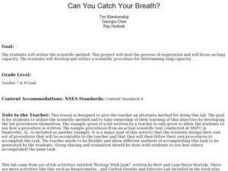Baylor College
Lungometer
Life science learners construct lung-o-meters from gallon-sized milk jugs and then measure their lung capacities. For older students, have them graph the vital lung capacities of each person in the class. Cross-curricular pieces are...
Curated OER
Respiratory Therapy
This plan has a PowerPoint, and two handouts attached. The concept is to clarify the structure and function of our respiratory system. Your class will like the activity with balloons that demonstrates lung capacity and the...
Curated OER
Lung Capacity
In this lung capacity instructional activity, students use straws, funneling, liquids, tubing, and more to test their lung capacity. Students follow 14 sets of directions and analyze their data.
Curated OER
How Big is a Breath?
Learners demonstrate how to use math skills to measure their lung capacity. In this human biology lesson, students use a clear plastic container, measuring cup and rubber balloons to demonstrate how the lungs work. Learners estimate the...
Curated OER
Catch your Breath
High schoolers measure lung capacity and explore factors that affect the amount of air the lungs can hold.
Curated OER
Lung Limit
Students explore one's lung capacity, the human body, displacing volume of water with volume of air and spirometer use. Using simple math, students figure out their lung capacity by breathing into a bottle filled with water and...
LABScI
Circulation and Respiration: Vital Signs
What do your vital signs tell your doctor? An engaging hands-on lesson has your learners monitor their own lung capacity, blood pressure, and heart rate. They then connect the vital measures to the workings of the circulatory and...
Curated OER
Balloon Lungs
Pupils study the function of lungs. In this lung function lesson, students complete an experiment using balloons to study the way lungs work. Pupils study a diagram of their lungs and make a hypothesis for their lung capacity experiment....
Curated OER
Lung Limit
Students determine their lung capacity by completing a science experiment with a bottle of water. In this lung science lesson, students discuss the lungs' purpose. Students complete an experiment to determine their lung capacity using a...
Curated OER
Biology: Lung Capacity
Students perform experiments to determine their lung capacity and respiration rate. After choosing and performing one of two methods to discover lung capacity, they measure their respiratory rates and assess conditions that affect them....
Curated OER
Measuring Lung Volume and Capacity
For this measuring lung volume and capacity worksheet, students perform several experiments testing for exhaled carbon dioxide, measuring lung volume, and measuring lung capacity.
Curated OER
Peak Flow Meter Exercise
Students investigate the concept of lung capacity. They use flow meters to measure the maximum capacity of themselves and others. The data is collected in order to make some conclusions concerning the mean of individual lung capacity....
Curated OER
What is your lung?s capacity?
Students observe and determine what their lung capcity is. They fill a two-liter bottle completely with water and place the cap back on. Students fill a dishpan half full of water. They place the cap-end of the bottle into the water in...
Curated OER
Cardiorespiratory Fitness
Students explore cardiorespiratory fitness. In this biology lesson plan, students gain an understanding of pulse rates in order to compare lung capacities of active and inactive males and females. They also learn how to take and compare...
Curated OER
How Do You Measure Up
Students investigate the concept of heart rate and how it is effected by environmental stresses like exercise. They conduct research readings and evaluate the data to form a hypothesis to initiate class discussion about the information.
Curated OER
Human Anatomy- How Do We Move?
Students explore the human anatomy. In this respiratory system lesson, students conduct an experiment to simulate the capacity of human lungs.
Curated OER
Can You Catch Your Breath?
Students apply the the scientific method to an investigation.They develop and perform a scientific procedure for determining lung capacity. In addition, they write a report to display information and share their procedures with the class.
Curated OER
How Might Radon Affect Me?
Learners participate in an experiment in which they discover the relationship between the lungs and radon. They identify the helpful and harmful aspects of radiation. They also research any illnesses related to exposure to radon gas.
Curated OER
Respiratory System
For this health worksheet, middle schoolers examine the human body and make mental connections to the target function highlighted in the sheet.
Curated OER
Science: Breathing in Space
Pupils determine the amount of air they use during rest and activity. They conduct experiments to calculate the number of breaths needed to empty a jug of water by exhaling through a tube into the container. Then, they figure how much...
Teachers TryScience
Teachers Try Science: Lung Capacity
This hands-on experiment shows you how to make your spirometer, a device you can use to measure how much air your lungs can hold.
Science Museum of Minnesota
Lesson Plan: Catch Your Breath
In this comprehensive site, students will measure their lung capacity and look at factors that affect the amount of air the lungs can hold.























